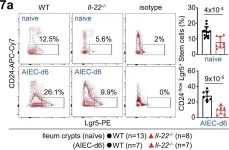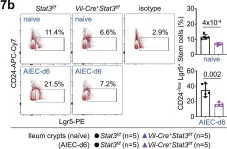Locoregional monotherapy with heterodimeric interleukin (IL)-15 (hetIL-15) in a triple-negative breast cancer (TNBC) orthotopic mouse model resulted in tumor eradication in 40% of treated mice, reduction of metastasis, and induction of immunological memory against breast cancer cells. hetIL-15 re-shaped the tumor microenvironment by promoting the intratumoral accumulation of cytotoxic lymphocytes, conventional type 1 dendritic cells (cDC1s), and a dendritic cell (DC) population expressing both CD103 and CD11b markers. These CD103intCD11b+DCs share phenotypic and gene expression characteristics with both cDC1s and cDC2s, have transcriptomic profiles more similar to monocyte-derived DCs (moDCs), and correlate with tumor regression. Therefore, hetIL-15, a cytokine directly affecting lymphocytes and inducing cytotoxic cells, also has an indirect rapid and significant effect on the recruitment of myeloid cells, initiating a cascade for tumor elimination through innate and adoptive immune mechanisms. The intratumoral CD103intCD11b+DC population induced by hetIL-15 may be targeted for the development of additional cancer immunotherapy approaches.
Published by Elsevier Inc.
Product Citations: 7
In Cell Reports on 30 May 2023 by Stellas, D., Karaliota, S., et al.
-
Mus musculus (House mouse)
-
Cancer Research
-
Immunology and Microbiology
In Immunity on 14 June 2022 by Gargaro, M., Scalisi, G., et al.
Conventional dendritic cells (cDCs), cDC1 and cDC2, act both to initiate immunity and maintain self-tolerance. The tryptophan metabolic enzyme indoleamine 2,3-dioxygenase 1 (IDO1) is used by cDCs in maintaining tolerance, but its role in different subsets remains unclear. At homeostasis, only mature CCR7+ cDC1 expressed IDO1 that was dependent on IRF8. Lipopolysaccharide treatment induced maturation and IDO1-dependent tolerogenic activity in isolated immature cDC1, but not isolated cDC2. However, both human and mouse cDC2 could induce IDO1 and acquire tolerogenic function when co-cultured with mature cDC1 through the action of cDC1-derived l-kynurenine. Accordingly, cDC1-specific inactivation of IDO1 in vivo exacerbated disease in experimental autoimmune encephalomyelitis. This study identifies a previously unrecognized metabolic communication in which IDO1-expressing cDC1 cells extend their immunoregulatory capacity to the cDC2 subset through their production of tryptophan metabolite l-kynurenine. This metabolic axis represents a potential therapeutic target in treating autoimmune demyelinating diseases.Copyright © 2022 The Author(s). Published by Elsevier Inc. All rights reserved.
-
FC/FACS
-
Mus musculus (House mouse)
-
Biochemistry and Molecular biology
-
Cell Biology
-
Immunology and Microbiology
IL-22 initiates an IL-18-dependent epithelial response circuit to enforce intestinal host defence.
In Nature Communications on 15 February 2022 by Chiang, H. Y., Lu, H. H., et al.
IL-18 is emerging as an IL-22-induced and epithelium-derived cytokine which contributes to host defence against intestinal infection and inflammation. In contrast to its known role in Goblet cells, regulation of barrier function at the molecular level by IL-18 is much less explored. Here we show that IL-18 is a bona fide IL-22-regulated gate keeper for intestinal epithelial barrier. IL-22 promotes crypt immunity both via induction of phospho-Stat3 binding to the Il-18 gene promoter and via Il-18 independent mechanisms. In organoid culture, while IL-22 primarily increases organoid size and inhibits expression of stem cell genes, IL-18 preferentially promotes organoid budding and induces signature genes of Lgr5+ stem cells via Akt-Tcf4 signalling. During adherent-invasive E. coli (AIEC) infection, systemic administration of IL-18 corrects compromised T-cell IFNγ production and restores Lysozyme+ Paneth cells in Il-22-/- mice, but IL-22 administration fails to restore these parameters in Il-18-/- mice, thereby placing IL-22-Stat3 signalling upstream of the IL-18-mediated barrier defence function. IL-18 in return regulates Stat3-mediated anti-microbial response in Paneth cells, Akt-Tcf4-triggered expansion of Lgr5+ stem cells to facilitate tissue repair, and AIEC clearance by promoting IFNγ+ T cells.
© 2022. The Author(s).
-
FC/FACS
-
Mus musculus (House mouse)
Minor intron retention drives clonal hematopoietic disorders and diverse cancer predisposition.
In Nature Genetics on 1 May 2021 by Inoue, D., Polaski, J. T., et al.
Most eukaryotes harbor two distinct pre-mRNA splicing machineries: the major spliceosome, which removes >99% of introns, and the minor spliceosome, which removes rare, evolutionarily conserved introns. Although hypothesized to serve important regulatory functions, physiologic roles of the minor spliceosome are not well understood. For example, the minor spliceosome component ZRSR2 is subject to recurrent, leukemia-associated mutations, yet functional connections among minor introns, hematopoiesis and cancers are unclear. Here, we identify that impaired minor intron excision via ZRSR2 loss enhances hematopoietic stem cell self-renewal. CRISPR screens mimicking nonsense-mediated decay of minor intron-containing mRNA species converged on LZTR1, a regulator of RAS-related GTPases. LZTR1 minor intron retention was also discovered in the RASopathy Noonan syndrome, due to intronic mutations disrupting splicing and diverse solid tumors. These data uncover minor intron recognition as a regulator of hematopoiesis, noncoding mutations within minor introns as potential cancer drivers and links among ZRSR2 mutations, LZTR1 regulation and leukemias.
-
FC/FACS
-
Mus musculus (House mouse)
-
Cancer Research
-
Genetics
In Cellular and Molecular Gastroenterology and Hepatology on 25 April 2021 by Go, D. M., Lee, S. H., et al.
Helicobacter pylori has been reported to modulate local immune responses to colonize persistently in gastric mucosa. Although the induced expression of programmed cell death ligand 1 (PD-L1) has been suggested as an immune modulatory mechanism for persistent infection of H pylori, the main immune cells expressing PD-L1 and their functions in Helicobacter-induced gastritis still remain to be elucidated.
The blockades of PD-L1 with antibody or PD-L1-deficient bone marrow transplantation were performed in Helicobacter-infected mice. The main immune cells expressing PD-L1 in Helicobacter-infected stomach were determined by flow cytometry and immunofluorescence staining. Helicobacter felis or H pylori-infected dendritic cell (DC)-deficient mouse models including Flt3-/-, Zbtb46-diphtheria toxin receptor, and BDCA2-diphtheria toxin receptor mice were analyzed for pathologic changes and colonization levels. Finally, the location of PD-L1-expressing DCs and the correlation with H pylori infection were analyzed in human gastric tissues using multiplexed immunohistochemistry.
Genetic or antibody-mediated blockade of PD-L1 aggravated Helicobacter-induced gastritis with mucosal metaplasia. Gastric classical DCs expressed considerably higher levels of PD-L1 than other immune cells and co-localized with T cells in gastritis lesions from Helicobacter-infected mice and human beings. H felis- or H pylori-infected Flt3-/- or classical DC-depleted mice showed aggravated gastritis with severe T-cell and neutrophil accumulation with low bacterial loads compared with that in control mice. Finally, PD-L1-expressing DCs were co-localized with T cells and showed a positive correlation with H pylori infection in human subjects.
The PD-1/PD-L1 pathway may be responsible for the immune modulatory function of gastric DCs that protects the gastric mucosa from Helicobacter-induced inflammation, but allows persistent Helicobacter colonization.
Copyright © 2021 The Authors. Published by Elsevier Inc. All rights reserved.
-
FC/FACS
-
Mus musculus (House mouse)
-
Immunology and Microbiology
In Nat Commun on 15 February 2022 by Chiang, H. Y., Lu, H. H., et al.
Fig.7.A

-
FC/FACS
-
Mus musculus (House mouse)
Collected and cropped from Nat Commun by CiteAb, provided under a CC-BY license
Image 1 of 3
In Nat Commun on 15 February 2022 by Chiang, H. Y., Lu, H. H., et al.
Fig.7.B

-
FC/FACS
-
Mus musculus (House mouse)
Collected and cropped from Nat Commun by CiteAb, provided under a CC-BY license
Image 1 of 3
In Nat Commun on 15 February 2022 by Chiang, H. Y., Lu, H. H., et al.
Fig.7.C

-
FC/FACS
-
Mus musculus (House mouse)
Collected and cropped from Nat Commun by CiteAb, provided under a CC-BY license
Image 1 of 3


